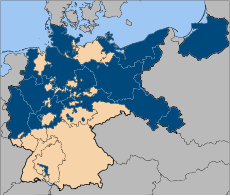Abolition of Prussia
show This article may be expanded with text translated from the corresponding article in German. (September 2013) Click [show] for important translation instructions. |
The formal abolition of Prussia (German: Abschaffung von Preußen) occurred on 25 February 1947, by decree of the Allied Control Council.
History[]

Prussia was for many centuries a major power in north-central Europe, based around the cities of Berlin and Königsberg, and rose to particular prominence during the eighteenth and nineteenth centuries. Following its victory in the Austro-Prussian War, Prussia became the driving force in creating a German Empire that excluded Austria (a Kleindeutsches Reich) and in 1871 the King of Prussia became German Emperor.
Following the First World War, the new Free State of Prussia bore most of Germany's territorial losses but remained the dominant state of the Weimar Republic. Even before Hitler came to power, the Prussian government had been effectively abolished by the Preußenschlag of 1932. Following World War II, almost all of Germany's territorial losses again were from areas that had been part of Prussia.
Prussia was officially abolished by Control Council Law No. 46, passed by the Allied occupation authorities, in 1947.
This resulted in the 1954 disbanding of the Prussian Academy of Arts.[1] In 1972, the Prussian Academy of Sciences was renamed. It was abolished and replaced by the Berlin-Brandenburg Academy of Sciences and Humanities in 1992 as part of the process of German reunification.
Law 46[]
Control Council Law No. 46:
The Prussian State which from early days has been a bearer of militarism and reaction in Germany has de facto ceased to exist.
Guided by the interests of preservation of peace and security of peoples and with the desire to assure further reconstruction of the political life of Germany on a democratic basis, the Control Council enacts as follows:
Article I
The Prussian State together with its central government and all its agencies are abolished.
Article II
Territories which were a part of the Prussian State and which are at present under the supreme authority of the Control Council will receive the status of Länder or will be absorbed into Länder.
The provisions of this Article are subject to such revision and other provisions as may be agreed upon by the Control Council, or as may be laid down in the future Constitution of Germany.
Article III
The State and administrative functions as well as the assets and liabilities of the former Prussian State will be transferred to appropriate Länder, subject to such agreements as may be necessary and made by the Allied Control Council.
Article IV
This law becomes effective on the day of its signature.
Signed in Berlin on February 25, 1947.
Control Council Law No. 46, signed on 25 February, liquidates the State of Prussia, its central government, and all its agencies. This law is in the nature of a confirming action; the eleven provinces and administrative districts of prewar Prussia have since the beginning of the occupation been split up among the Soviet, British, and American Zones and Poland.[2]
See also[]
- Legal status of Germany
- Reconstruction of Germany
- Danzig Corridor
- Danzig crisis
- Free City of Danzig (following Free City of Danzig (Napoleonic))
- Reichsgau Danzig-West Prussia
pacts:
- Anglo-Polish military alliance
- German–Polish Non-Aggression Pact
- Molotov–Ribbentrop Pact
- Soviet–Polish Non-Aggression Pact
References[]
- ^ Parker, Stephen; Philpotts, Matthew (16 October 2009). "Sinn und Form": The Anatomy of a Literary Journal. p. 377. ISBN 9783110217865.
Künste Berlin contains the archives that have been accumulated since 1696 in the various incarnations of the present Berlin Academy of Arts: from the Prussian Academy of Arts, which ceased to exist with the abolition of Prussia after 1945
- ^ Excerpt from Legal and Judicial Affairs (Bimonthly Review), OMGUS Report No. 20, 1 Jan–28 Feb 1947.
Bibliography[]
- Ernst Rudolf Huber (1951), Sources of Constitutional Law of the modern era, Volume 2, Matthiesen & Co, p. 648, OCLC 45536654
External links[]
- Text of the Document
- Text of the Document (in German)
- 1947 in Germany
- 1940s in Prussia
- Allied occupation of Germany
- Dissolutions of countries
- Prussian law
- February 1947 events
- History of Prussia
- Politics of Prussia
- Legal history of Germany
- Political history of Germany
- Former subdivisions of Germany
- 1947 in politics